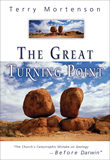Gap Theory
According to the gap theory, there’s a very long gap of time between Genesis 1:1 and 1:2. The world that existed during this gap was destroyed and God re-created in the six days described in Genesis. This idea fails because it lacks biblical support and puts death before sin when Scripture describes death as the consequence for sin.
Gap Theory Examined Biblically
This brief overview shows that the gap theory is not biblical. It is, in fact, a compromise of the truth of Genesis, which arose when Christian leaders tried to accommodate the millions of years claimed for fossil layers.
Hebrew Words and the Gap Theory
Many adherents of the gap theory claim that the grammar of Genesis 1:1–2 allows, and even requires, a time-gap between the events in verse 1 and the events in verse 2. Into this gap—believed by many to be billions of years—they want to place all the major geological phenomena that have shaped the world.
Variations of the Gap Theory
The “modified gap theory” or “precreation chaos gap theory,” which is the proposed “gap” between Genesis 1:2 and 1:3, is unscriptural, and ultimately unnecessary. In fact, several gap models have been proposed over the years for one reason—to add secular ideas of long ages to the Bible.
Articles About Gap Theory
-
March 12, 2023 from Answers Magazine
Gap theorists insert millions of years between the first two verses of Genesis. But what really lurks in that gap?
-
Dec. 20, 2019 from The New Answers Book 1
Because of the accepted teachings of evolution, many Christians have tried to place a gap of indeterminate time between the first two verses of Genesis 1.
-
June 2, 2013 from Answers Magazine
Two centuries ago in an effort to explain “prehistoric” fossils, Christian leaders introduced the idea that a gap of time is missing between Genesis 1:1 and 1:2.
-
Mind the GapJune 30, 2008, p. 40
The gap theory is simply compromise. It is an attempt to harmonise the facts of Scripture with the ideas of fallen men.
-
Feedback ArticleRecollections of an Ex-Gap-TheoristDec. 9, 2005 from Feedback
Judie from Australia shares her past experiences with the Gap Theory, as a follow up to last week's feedback on the topic.
-
A Gap in KnowledgeApril 12, 2001
A well-known US ‘televangelist’ (i.e. television preacher), who frequently appears on the Trinity Broadcasting Network (TBN), recently promoted the compromise view known as the ‘gap theory.’
-
Magazine ArticleThe Gap Theory—an Idea with Holes?Dec. 1, 1987, pp. 35–37
Many people assume there is a great gap in time between Genesis 1:1 and Genesis 1:2.
-
Magazine ArticleThe Gap Theory (Part B)Aug. 1, 1980, pp. 33–34
The interpretation of Genesis 1:1–2, as it applies to the Gap (Ruin-Reconstruction) Theory, revolves around four major points.
-
Magazine ArticleThe Gap Theory (Part A)Aug. 1, 1980, pp. 11–12
There have been many attempts to harmonize or combine the Genesis account of the creation with orthodox “modern” geology—e.g. theistic evolution and progressive creation.
Recommended Resources

Answers in Genesis is an apologetics ministry, dedicated to helping Christians defend their faith and proclaim the good news of Jesus Christ.
- Customer Service 800.778.3390
- Available Monday–Friday | 9 AM–5 PM ET
- © 2025 Answers in Genesis






